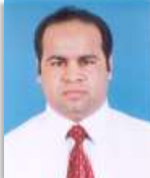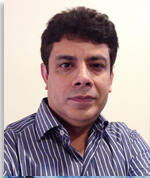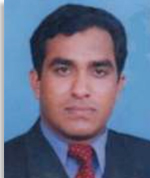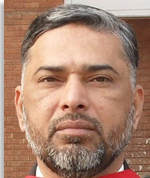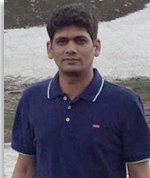Last Three Year Articles
Year:
2015
1-
Dr. Bilal Masud,; Near-stability of quasi-minimal surface indicated through a tested curvature algorithm, Computers & Mathematics with Applications, 69 (10), 2015
2-
Dr. Munawar Iqbal,; Fabrication and temperature dependent magnetic properties of nickel nanowires embedded in alumina templates, Ceramic International, 41, 2015
3-
Dr. Maqsood Ahmad,; Automatic Ferrite Content Measurement based on Image Analysis and Pattern Classification, International Journal of Advanced Computer Science and Applications, 6 (5), 2015
4-
Dr. M. Qadeer Afzal Malik, Dr. Talab Hussain , Dr. Abrar Ahmad Zafr BESII Collaboration,; Search for the Y(4140) via e+e−→γϕJ/ψ at s√=4.23, 4.26 and 4.36 GeV, Phys. review D, 91, 2015
5-
Dr. M. Qadeer Afzal Malik, Dr. Talab Hussain , Dr. Abrar Ahmad Zafar BESII Collaboration,; Precision measurement of the D*0 decay branching fractions, Phys. review D, 91, 2015
6-
Dr. M. Qadeer Afzal Malik, Dr. Talab Hussain, Dr. Abrar Ahmad Zafar BESIII Collaboration,; Study of e+e−→ωχcJ at Center of Mass Energies from 4.21 to 4.42 GeV, Phys. Rev. Lett, 114, 2015
7-
Dr. M. Qadeer Afzal Malik, Dr. Talab Hussain, Dr. Abrar Ahmad Zafar BESIII Collaboration,; Study of J/ψ→ηϕπ+π− at BESIII, Phys. Rev. D, 91, 2015
8-
Dr. M. Qadeer Afzal Malik, Dr. Talab Hussain, Dr. Abrar Ahmad Zafar BESIII Collaboration,; Measurements of ψ(3686)→K−ΛΞ¯++c.c. and ψ(3686)→γK−ΛΞ¯++c.c., Phys. Rev. D, 91, 2015
9-
Dr. M. Qadeer Afzal Malik, Dr. Talab Hussain, Dr. Abrar Ahmad Zafar BESIII Collaboration,; Measurement of B(ψ(3770)→γχc1) and search for ψ(3770)→γχc2, Phys. Rev. D, 91, 2015
10-
Dr. M. Qadeer Afzal Malik, Dr. Talab Hussain, Dr. Abrar Ahmad Zafar BESIII Collaboration,; Observation of the electromagnetic doubly OZI-suppressed decay J/ψ→ϕπ0, Phys. Rev. D, 91, 2015
11-
Dr. M. Qadeer Afzal Malik, Dr. Talab Hussain, Dr. Abrar Ahmad Zafar BESIII Collaboration,; Measurement of the e+e−→ηJ/ψ cross section and search for e+e−→π0J/ψ at center-of-mass energies between 3.810 and 4.600 GeV, Phys. Rev. D, 91, 2015
12-
Dr. M. Qadeer Afzal Malik, Dr. Talab Hussain, Dr. Abrar Ahmad Zafar BESIII Collaboration,; Measurement of the proton form factor by studying e+e−→pp¯, Phys. Rev. D, 91, 2015
13-
Dr. M. Qadeer Afzal Malik, Dr. Talab Hussain, Dr. Abrar Ahmad Zafar BESIII Collaboration,; Study of χcJ decaying into ϕK∗(892)K¯, Phys. Rev. D, 91, 2015
14-
Dr. M. Qadeer Afzal Malik, Dr. Talab Hussain, Dr. Abrar Ahmad Zafar BESIII Collaboration,; Search for D0→γγ and improved measurement of the branching fraction for D0→π0π0, Phys. Rev. D, 91, 2015
15-
Dr. M. Qadeer Afzal Malik, Dr. Talab Hussain, Dr. Abrar Ahmad Zafar BESIII Collaboration,; Searches for isospin-violating transitions χc0,2→π0ηc, Phys. Rev. D, 91, 2015
16-
Dr. M. Qadeer Afzal Malik, Dr. Talab Hussain, Dr. Abrar Ahmad Zafar BESIII Collaboration,; Observation of the ψ(1 D23) State in e+e−→π+π−γχc1 at BESIII, Phys. Rev. Lett., 115, 2015
17-
Dr. M. Qadeer Afzal Malik, Dr. Talab Hussain, Dr. Abrar Ahmad Zafar BESIII Collaboration,; Observation of the Dalitz decay η'→γe+e−, Phys. Rev. D, 92, 2015
18-
Dr. M. Qadeer Afzal Malik, Dr. Talab Hussain, Dr. Abrar Ahmad Zafar BESIII Collaboration,; Search for the isospin violating decay Y(4260)→J/ψηπ0, Phys. Rev. D, 92, 2015
19-
Dr. M. Qadeer Afzal Malik, Dr. Talab Hussain, Dr. Abrar Ahmad Zafar BESIII Collaboration,; Observation of the isospin-violating decay J/ψ→ϕπ0f0(980), Phys. Rev. D, 92, 2015
20-
Dr. M. Qadeer Afzal Malik, Dr. Talab Hussain, Dr. Abrar Ahmad Zafar BESIII Collaboration,; Measurement of the matrix elements for the decays η→π+π−π0 and η/η′→π0π0π0, Phys. Rev. D, 92, 2015
21-
Dr. Irfan Mahmood,; Quaside terminant solutions of NC Painlev e II equation with the Toda solution at n=1 as a seed solution in its Darboux transformation, Journal of Geometry and Physics, 95, 2015
22-
Mr. Abdul Rehman
(Visiting Faculty),; Astroglial U87 cells protect neuronal SH-SY5Y cells from indirect effect of radiation by reducing DNA damage and inhibiting Fas mediated apoptotic pathway in coculture system, Neuro Chemical Research, 40, 2015
23-
Dr. Qadeer Afzal Malik
Dr. Abrar Ahmad Zafar &Dr. Talab Hussain,; "Study of J/Psi to eta phi pi + pl - at BESIII", BESIII Collaboration, Phys. Rev. D (USA) , , 2015
24-
Dr. Qadeer Afzal Malik
Dr. Abrar Ahmad Zafar &Dr. Talab Hussain,; "Observation of electromagnetic Dalitz decays J/ψ ˗pe+e-"BESIII Collaboration, Phys. Rev. D (USA) , , 2015
25-
Dr. Qadeer Afzal Malik
Dr. Abrar Ahmad Zafar &Dr. Talab Hussain,; "Observation of e+ e-π0 π0 hc and a Neurtal Charmoniumlike Structure Zc(4020)0" BESIII Collaboration, Phys. Rev. D (USA) , , 2015
26-
Dr. Qadeer Afzal Malik
Dr. Abrar Ahmad Zafar &Dr. Talab Hussain,; Precision measurement sof the D*0 decay branching fractions, BESII Collaboration, Phys. Rev. D (USA) , , 2015
27-
Dr. Qadeer Afzal Malik
Dr. Abrar Ahmad Zafar &Dr. Talab Hussain,; Publisher's note: observation of J/ψ→pp a0 (980) at BESIII, Phys. Rev. D (USA) , , 2015
28-
Dr. Qadeer Afzal Malik
Dr. Abrar Ahmad Zafar &Dr. Talab Hussain,; Observation and spin parity determination of the X(1835) in J/ψ→kos kosη, BESIII Collaboration, Phys.Rev.D(USA), , 2015
29-
Dr. Qadeer Afzal Malik
Dr. Abrar Ahmad Zafar &Dr. Talab Hussain,; Observation of Zc(3900)o in e+e-π0π0J/ψ, BESIII Collaboration, Phys..Rev.D(USA), , 2015
30-
Dr. Qadeer Afzal Malik
Dr. Abrar Ahmad Zafar &Dr. Talab Hussain,; Observation ofή→ω e+e-, BESIII Collaboration, Phys.Rev.D(USA), , 2015
31-
Dr. Qadeer Afzal Malik
Dr. Abrar Ahmad Zafar &Dr. Talab Hussain,; Evidence for e+eYXc1,2 at center of mass energies from 4.009 to 4.360 GeV, BESIII Collaboration, Chin.Phys. C(China), , 2015
32-
Dr. Qadeer Afzal Malik
Dr. Abrar Ahmad Zafar &Dr. Talab Hussain,; Measurment of the branching fractions of Ds+ ήX and +D+s→ήp+in e+e-→Ds+Ds- BESIII Collaboration, Phys. Lett. B(USA), , 2015
33-
Dr. Qadeer Afzal Malik
Dr. Abrar Ahmad Zafar &Dr. Talab Hussain,; An improved limit for Tee of X(3872) and Tee measurment of (3686), BESIII Collaboration, Phys. Lett. B(USA), , 2015
34-
Dr. Qadeer Afzal Malik
Dr. Abrar Ahmad Zafar &Dr. Talab Hussain,; Measurement of YCP in Do-Do oscillation using quantum correlations in e+e- D0D0 at √s=3.773 GeV, BESIII Collaboration, Phys.Lett. B(USA), , 2015
35-
Dr. Qadeer Afzal Malik
Dr. Abrar Ahmad Zafar &Dr. Talab Hussain,; Observation of a neutral structure near the DD*Mass Threshold in e+e- (DD*)0 0 at S=4.226 and 4.257 GeV, BESIII Collaboration, Phys.Lett. (USA), , 2015
36-
Dr. Qadeer Afzal Malik
Dr. Abrar Ahmad Zafar &Dr. Talab Hussain,; Measurment of the absolute Branching Fraction for A+c Ae+Ve, BESIII Collaboration, Phys.Lett (USA), , 2015
37-
Dr. Munawar Iqbal,; Influence of Cobalt doping on structural and magnetic properties of BiFeO3 nanoparticles, Journal of Nanoparticle, 17, 2015
38-
Dr. Munawar Iqbal,; Structural and Magnetic Studies of NixCo0.8-xMn0.2Fe2O4 Nanoparticles Prepared via Co-precipitation Rout, Ceramics International, 52, 2015
39-
Dr. Muhammad Ayub Faridi,; First-principles investigation of structural, elastic, electronic and magnetic properties of Be0.75Co0.25Y (Y, The Nucleus, 15, 2015
40-
Dr. Abrar Ahmad Zafar, Dr. Talab Hussain, Dr. Qadeer Afzal Malik,; double bond; length as m-dashS, Se and Te) compounds, Current Applied Physics, 115, 2015
41-
Dr. Abrar Ahmad Zafar, Dr. Talab Hussain, Dr. Qadeer Afzal Malik,; Search for Zc(3900)±→ωπ± (BESIII Collaboration), Phys. Rev. Lett, 92, 2015
42-
Dr. Abrar Ahmad Zafar, Dr. Talab Hussain, Dr. Qadeer Afzal Malik,; Observation of Zc(3900)0 in e+e−→π0π0J/ψ (BESIII Collaboration), Phys. Rev. D, 115, 2015
43-
Dr. Abrar Ahmad Zafar, Dr. Talab Hussain, Dr. Qadeer Afzal Malik,; Amplitude analysis of the π0π0 system produced in radiative J/ψ decays (BESIII Collaboration), Phys. Rev. D, 92, 2015
44-
Dr. Abrar Ahmad Zafar, Dr. Talab Hussain, Dr. Qadeer Afzal Malik,; Observation of η′→ωe+e− (BESIII Collaboration), Phys. Rev. D, 92, 2015
45-
Dr. Abrar Ahmad Zafar, Dr. Talab Hussain, Dr. Qadeer Afzal Malik,; Measurement of the form factors in the decay D+→ωe+νeand search for the decay D+→ϕe+νe (BESIII Collaboration), Phys. Rev. D, 92, 2015
46-
Dr. Abrar Ahmad Zafar, Dr. Talab Hussain, Dr. Qadeer Afzal Malik,; Study of dynamics of D0→K−e+νe and D0→π−e+νedecays (BESIII Collaboration), Phys. Rev. D, 92, 2015
47-
Dr. Abrar Ahmad Zafar, Dr. Talab Hussain, Dr. Qadeer Afzal Malik,; Observation of a Neutral Charmoniumlike State Zc(4025)0in e+e−→(D∗D¯∗)0π0 (BESIII Collaboration), Phys. Rev. Lett, 115, 2015
48-
Dr. Abrar Ahmad Zafar, Dr. Talab Hussain, Dr. Qadeer Afzal Malik,; Confirmation of a charged charmoniumlike state Zc(3885)∓in e+e−→π±(DD¯∗)∓ with double D tag (BESIII Collaboration), Phys. Rev. D, 92, 2015
49-
Dr. Abrar Ahmad Zafar, Dr. Talab Hussain, Dr. Qadeer Afzal Malik,; Observation of a Neutral Structure near the DD¯∗ Mass Threshold in e+e−→(DD¯∗)0π0 at s√=4.226 and 4.257 GeV (BESIII Collaboration), Phys. Rev. Lett, 115, 2015
50-
Dr. Abrar Ahmad Zafar, Dr. Talab Hussain, Dr. Qadeer Afzal Malik,; Measurement of the Absolute Branching Fraction for Λ+c→Λe+νe (BESIII Collaboration), Phys. Rev. Lett, 115, 2015
51-
Dr. Abrar Ahmad Zafar, Dr. Talab Hussain, Dr. Qadeer Afzal Malik,; Study of decay dynamics and CP asymmetry in D+→K0Le+νe decay (BESIII Collaboration), Phys. Rev. Lett, 115, 2015
Year:
2014
1-
Dr. Qadeer Afzal Malik, Dr. Talab Hussain & Dr. Abrar Ahmad Zafar,; Search for the weak decays J/ψ→ Ds(*)-e+ve-c.c (BESIII collaboration), Phys. Rev. D, 90, 2014
2-
Dr. Bilal Masud,; Variational Mimimization on string rearangment surfaces, illustrated by an analysis of bilinear interpolation, Applied Mathematics and Computation, 233, 2014
3-
Dr. Qadeer Afzal Malik, Dr. Talab Hussain & Dr. Abrar Ahmad Zafar,; Observation of e+e-→π0π0hc and a neutral charmonium like structure Zc(4020)0 (BESIII Collaboration), Phys. Rev. Lett, 113, 2014
4-
Dr. Bilal Masud, Dr. Faisal Akram, Mr. Muhamamd Atif Sultan,; Higher Hybrid charmonia in an extended potential model, Physical review D, 90, 2014
5-
Dr. Qadeer Afzal Malik, Dr. Talab Hussain & Dr. Abrar Ahmad Zafar,; Search for C-parity violation in J/ψ→γγ and γ(BESIII Collaboration), Phys. Rev. D, 90, 2014
6-
Dr. Munawar Iqbal,; Simulation and test of a strip source electron gun, Review of scientific instruments, 85, 2014
7-
Dr. Munawar Iqbal,; Finite element analyses of a linear accelerator electron gun, Review of scientific instruments, 85, 2014
8-
Dr. Munawar Iqbal,; Electron gun jitter effects on beam bunching, Review of scientific instruments, 85, 2014
9-
Dr. Munawar Iqbal,; Enhanced photocatalytic and electrochemical properties of Au nano particles supported TiO2 microspheres, New jurnal of chemistry, 38, 2014
10-
Dr. Munawar Iqbal,; Design optimization of the Hairpin source electron gun using EGUN, VACUUM, 101, 2014
11-
Dr. Maqsood Ahmed,; Comparative study of structural and electronic properties of TiO2 at GGA and GGA+U level, Journal of Optoelectronics and advanced materials, 16, 2014
12-
Dr. Maqsood Ahmed, Dr. Talab Hussain & Dr. Abrar Ahmad Zafar,; Elastic, electronic and optical properties of baddeleyite TiO2 by fist principles, Materials science in semiconductor processing, 27, 2014
13-
Dr. Qadeer Afzal Malik , Dr. Talab Hussain & Dr. Abrar Ahmad Zafar,; Measurement of the branching fraction for ψ(3686)→ωK+K−, Phys. Rev. D, 89, 2014
14-
Dr. Qadeer Afzal Malik , Dr. Talab Hussain & Dr. Abrar Ahmad Zafar,; Observation of η′→π+π−π+π− and η′→π+π−π0π0, Phys. Rev. Lett., 112, 2014
15-
Dr. Qadeer Afzal Malik, Dr. Talab Hussain & Dr. Abrar Ahmad Zafar,; Amplitude analysis of the D+→KS0π+π0 Dalitz plot, Phys. Rev. D, 89, 2014
16-
Dr. Qadeer Afza Malik, Dr. Talab Hussain & Dr. Abrar Ahmad Zafar,; Study of e+e−→pp¯π0 in the vicinity of the ψ(3770), Phys. Rev. D, 90, 2014
17-
Dr. Qadeer Afzal Malik , Dr. Talab Hussain & Dr. Abrar Ahmad Zafar,; Observation of J/ψ→pp¯a0(980) at BESIII, Phys. Rev. D, 90, 2014
18-
Dr. Qadeer Afzal Malik , Dr. Talab Hussain & Dr. Abrar Ahmad Zafar,; Observation of electromagnetic Dalitz decays J/ψ→Pe+e−, Phys. Rev. D, 89, 2014
19-
Dr. Qadeer Afzal Malik , Dr. Talab Hussain & Dr. Abrar Ahmad Zafar,; Search for the rare decays J/ψ→Ds−ρ+ and J/ψ→D¯0K¯*0, Phys. Rev. D, 89, 2014
20-
Dr. Qadeer Afzal Malik , Dr. Talab Hussain & Dr. Abrar Ahmad Zafar,; Precision measurement of the mass of the τ lepton, Phys. Rev. D, 90, 2014
21-
Dr. Qadeer Afzal Malik , Dr. Talab Hussain & Dr. Abrar Ahmad Zafar,; Observation of a Charged (DD¯*)± Mass Peak in e+e−→πDD¯* at s=4.26 GeV, Phys. Rev. Lett, 112, 2014
22-
Dr. Qadeer Afzal Malik , Dr. Talab Hussain & Dr. Abrar Ahmad Zafar,; Measurement of χcJ decaying into η′K+K−, Phys. Rev. D, 89, 2014
23-
Dr. Qadeer Afzal Malik , Dr. Talab Hussain & Dr. Abrar Ahmad Zafar,; Search for the radiative transitions ψ(3770)→γηc and γηc(2S), Phys. Rev. D, 89, 2014
24-
Dr. Qadeer Afzal Malik , Dr. Talab Hussain & Dr. Abrar Ahmad Zafar,; Precision measurements of B(D+→μ+νμ), the pseudoscalar decay constant fD+, and the quark mixing matrix element |Vcd|, Phys. Rev. D, 89, 2014
25-
Dr. Qadeer Afzal Malik , Dr. Talab Hussain & Dr. Abrar Ahmad Zafar,; Observation of a Charged Charmoniumlike Structure in e+e−→(D*D¯*)±π∓ ats=4.26 GeV, Phys. Rev. Lett, 89, 2014
26-
Dr. Qadeer Afzal Malik , Dr. Talab Hussain & Dr. Abrar Ahmad Zafar,; Observation of e+e−→γX(3872) at BESIII, Phys. Rev. Lett, 112, 2014
27-
Dr. Abdul Aziz Bhatti,; Zero texture lepton mars matrices and near tribimaximal mixing in so(10) theory, Mod. Phys.Lett., A929, 2014
Year:
2013
1-
Mr. Faisal Akram,; Optimization of Neutrino Oscillation Parameters using Differetial Evolution, Commun. Theoro. Phys. 59 (2013), 50, 2013
2-
Dr. Bilal Masud &
Mr. Faisal Akram,; Vacuum Polarization and Dynamical Chiral Symmety Breaking: Phase Diagrams of QED with Four-Fermion Contact Interaction 25.01.2013, Phys. Rev. D, 87, 2013
Year:
2012
1-
Mr. Faisal Akram,; Bc Absorption Cross Section by Nucleons, Nucl.Phys. A, 877, 2012
2-
Dr. Munawar Iqbal Dr. M.Ayub Faridi,; Optimization of electrostatic focusing for line source electron beam emitter assembly, Physics procedia, 32, 2012
3-
Dr. Munawar Iqbal,; Design modification in rotor blade of a turbo molecular pump , Nuclear instruments and methods in physics research A, 678, 2012
4-
Dr. Bilal Masud,; Dynamical implications of gluonic excitations in meson-meson systems, Eur.Phys.J.A, 2.0173611111, 2012
5-
Dr. Haris Rashid
Dr. Qadeer Afzal
Dr. Abrar A,Zafar
Dr. Talab Hussain
,; Spin-Parity Analysis of pp? Mass Threshold Structure in J/? and ?(3686) Radiative Decays (BESIII Collaboration), Phys. Rev. Lett., 108, 2012
6-
Dr. Haris Rashid
Dr. Qadeer Afzal
Dr. Abrar A,Zafar
Dr. Talab Hussain
,; First Observation of ?(1405) Decays into f0(980)?0 (BESIII Collaboration), Phys. Rev. Lett., 108, 2012
7-
Dr. Haris Rashid
Dr. Qadeer Afzal
Dr. Abrar A,Zafar
Dr. Talab Hussain
,; Search for a light exotic particle in J/? radiative decays (BESIII Collaboration), Phy.Rev.D., 85, 2012
8-
Dr. Haris Rashid
Dr. Qadeer Afzal
Dr. Abrar A,Zafar
Dr. Talab Hussain
,; Measurements of the Mass and Width of the ?c Using the Decay ?(3686)???c
(BESIII Collaboration)
, Phys. Rev. Lett., 108, 2012
9-
Dr. Haris Rashid
Dr. Qadeer Afzal
Dr. Abrar A,Zafar
Dr. Talab Hussain
,; 1. Two-photon widths of the ?c0,2 states and helicity analysis for ?c2???
(BESIII Collaboration), Phy.Rev.D., 85, 2012
Year:
2011
1-
Faisal Akram,; Bc Absorption Cross Section by Nucleons, Nucl.Phys. A, 877, 2011
2-
Faisal Akram,; Bc Absorption Cross Section by ? Mesons, Phys.
Rev.C
, 84, 2011
3-
Dr. Munawar Iqbal,; Laser Induced Forward Transfer (LIFT) of Materials using 40-ps Pulses – Experimental and Quantitative Modilization Study., J.of Laser Micro/
Nanoeng.
, 6, 2011
4-
Dr. Bilal Masud,; Wave Function Based Characteristics of Hybrid Mesons, Eur.Phys.J.A., 47:124, 2011
5-
Dr. Haris Rashid, Dr. Qadeer Afzal , Dr. Abrar A. Zafar, Dr. Talab Hussain,; Search for ?c' decays into vector meson pairs, Phys.Rev.D., 84, 2011
6-
Dr. Haris Rashid, Dr. Qadeer Afzal , Dr. Abrar A. Zafar, Dr. Talab Hussain,; “Higher-order multipole amplitude measurement in , Phys.Rev.D., 84, 2011
7-
Dr. Haris Rashid, Dr. Qadeer Afzal , Dr. Abrar A. Zafar, Dr. Talab Hussain,; Observation of chi_c1 decays into vector meson pairs phi phi, omega omega and omega phi, Phys.Rev.Lett., 107, 2011
8-
Dr. Haris Rashid, Dr. Qadeer Afzal , Dr. Abrar A. Zafar, Dr. Talab Hussain,; "Search for CP/P violation process preudoscalar decays into pipi", Phys.Rev.D., 84, 2011
9-
Dr. Haris Rashid, Dr. Qadeer Afzal , Dr. Abrar A. Zafar, Dr. Talab Hussain,; "ηπ+π- Resonant Structure around 1.8GeV/c2 and η(1405) in J/ψ→ωηπ+π-, Phys.Rev.Lett, 107, 2011
Year:
2010
1-
Dr. Qadeer Afzal
(BES Collaboration),; Study of J/??, Physics Letter B, 685, 2010
2-
Dr. Qadeer Afzal
(BES Collaboration),; Measurement of the asymmetry parameter for the decay, Physical Review D, 81, 2010
3-
Dr. Qadeer Afzal
(BES Collaboration),; Search for y (3770)® Charmless final states involving h or p0 mesons , European Physics Journal C, 66, 2010
4-
Dr. Munawar Iqbal,; Surface Modification of mild steel with Boron Carbide reinforcement by electron beam melting., Vacuum, 85, 2010
5-
Dr. Munawar Iqbal,; Laser Induced forward Transfer (LIFT) of materials using ablation of thin films., Radiation Effects and Defects in Solids., 165, 2010
6-
Dr. Munawar Iqbal,; Optical Analysis of Germanium Carbide Thin Film Deposited by Reactive Pulsed Laser Ablation, Journal of Laser Micro/Nano -engineering, 5, 2010
7-
Dr. Haris Rashid
Dr. Qadeer Afzal
Abrar Ahmad Zafar
Talab Hussain
,; Evidence for y / decays into , Physical Review Letters, 105, 261801, 2010
Last Three Year Books
Year:
2015
1-
Dr. Muhammad Saleem
Professor Emeritus,; Title: Album Publisher: Punjab University Press, Year: 2015





